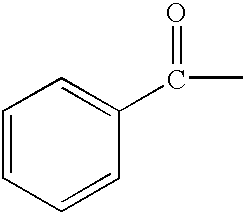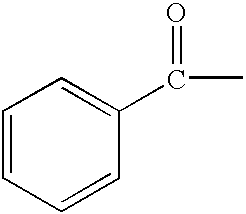Degradable chemiluminescent process and product
a chemiluminescent and biodegradable technology, applied in the field of chemiluminescent processes and products, can solve the problems of failing to teach or suggest a biodegradable chemiluminescent device, and achieve the effect of reducing the inherent non-degradable characteristics and easy degradation
- Summary
- Abstract
- Description
- Claims
- Application Information
AI Technical Summary
Benefits of technology
Problems solved by technology
Method used
Image
Examples
example 1
Device that Disintegrates but does not Biodegrade
[0053]Extrude into a tubular form a starch / polyolefin combination. Heat seal one end and fill with a typical chemical light oxalate solution (91.6% deputy phthalate, 8.4% CPPO, 0.19% BPEA). Float within the oxalate solution a sealed glass vial containing a typical chemical light activator solution (85% dimethyl phthalate, 10% t-butanol, 5% of 70% concentration hydrogen peroxide, 0.0085% sodium salicylate). Heat seal the remaining end. Flex to break the glass vial and light will result. Drop the device into water and it will soften and then dissolve. However, the polyolefin will remain and be unaffected over a long period of time (decades). Additionally, although not environmentally hazardous in small quantities, e.g. that found in a lightstick, the solvents, if released in large quantities may present environmental and toxicological problems as known marine pollutants (dibutyl phthalate) and possible endocrine disruptors (dimethyl pht...
example 2
Device that Disintegrates and Partially Biodegrades
[0054]Extrude into a tubular form a polyvinyl alcohol / polyvinyl acetate combination. Heat seal one end and fill with a typical chemical light oxalate solution (91.6% dibutyl phthalate, 8.4% CPPO, 0.19% BPEA). Float within the oxalate solution a sealed glass vial containing a typical chemical light activator solution (85% dimethyl phthalate, 10% t-butanol, 5% of 70% concentration hydrogen peroxide, 0.0085% sodium salicylate). Heat seal the remaining end. Flex to break the glass vial and light will result. Drop the device into water and it will soften and then dissolve. With the addition of normal soil bacteria, the polyvinyl alcohol / polyvinyl acetate combination will be consumed (this PVA combination has the same bioavailability as cellulose in the normal environment). Although not environmentally hazardous in small quantities, e.g. that found in a lightstick, the solvents, if released in large quantities may present environmental an...
example 3
Device that Disintegrates and Partially Biodegrades
[0055]Extrude into thin sheet form a ketone carbonyl copolymer (vinyl ketone comonomer inserted into polyethylene). Thermoform it into a shallow cup with a lip. Drop into the cup a non-woven polyester felt pad or sheet and two sealed glass vials, one containing a typical oxalate component (91.6% dibutyl phthalate, 8.4% CPPO, 0.19% BPEA) and the other containing a typical activator component (85% dimethyl phthalate, 10% t-butanol, 5% of 70% concentration hydrogen peroxide, 0.0085% sodium salicylate). Heat seal a flat sheet of the ketone carbonyl copolymer onto the cup lip, forming a sealed container with the felt sheet and vials. Flex the entire unit, breaking the glass vials and allowing the liquids to mix and soak into the felt, creating light. Leave the light device outside where is can and will be exposed to sunlight (and in particular, UV light). The plastic container will degrade and disintegrate. It may reenter the food chain ...
PUM
| Property | Measurement | Unit |
|---|---|---|
| quantum efficiency | aaaaa | aaaaa |
| quantum efficiency | aaaaa | aaaaa |
| concentration | aaaaa | aaaaa |
Abstract
Description
Claims
Application Information
 Login to View More
Login to View More - R&D
- Intellectual Property
- Life Sciences
- Materials
- Tech Scout
- Unparalleled Data Quality
- Higher Quality Content
- 60% Fewer Hallucinations
Browse by: Latest US Patents, China's latest patents, Technical Efficacy Thesaurus, Application Domain, Technology Topic, Popular Technical Reports.
© 2025 PatSnap. All rights reserved.Legal|Privacy policy|Modern Slavery Act Transparency Statement|Sitemap|About US| Contact US: help@patsnap.com


